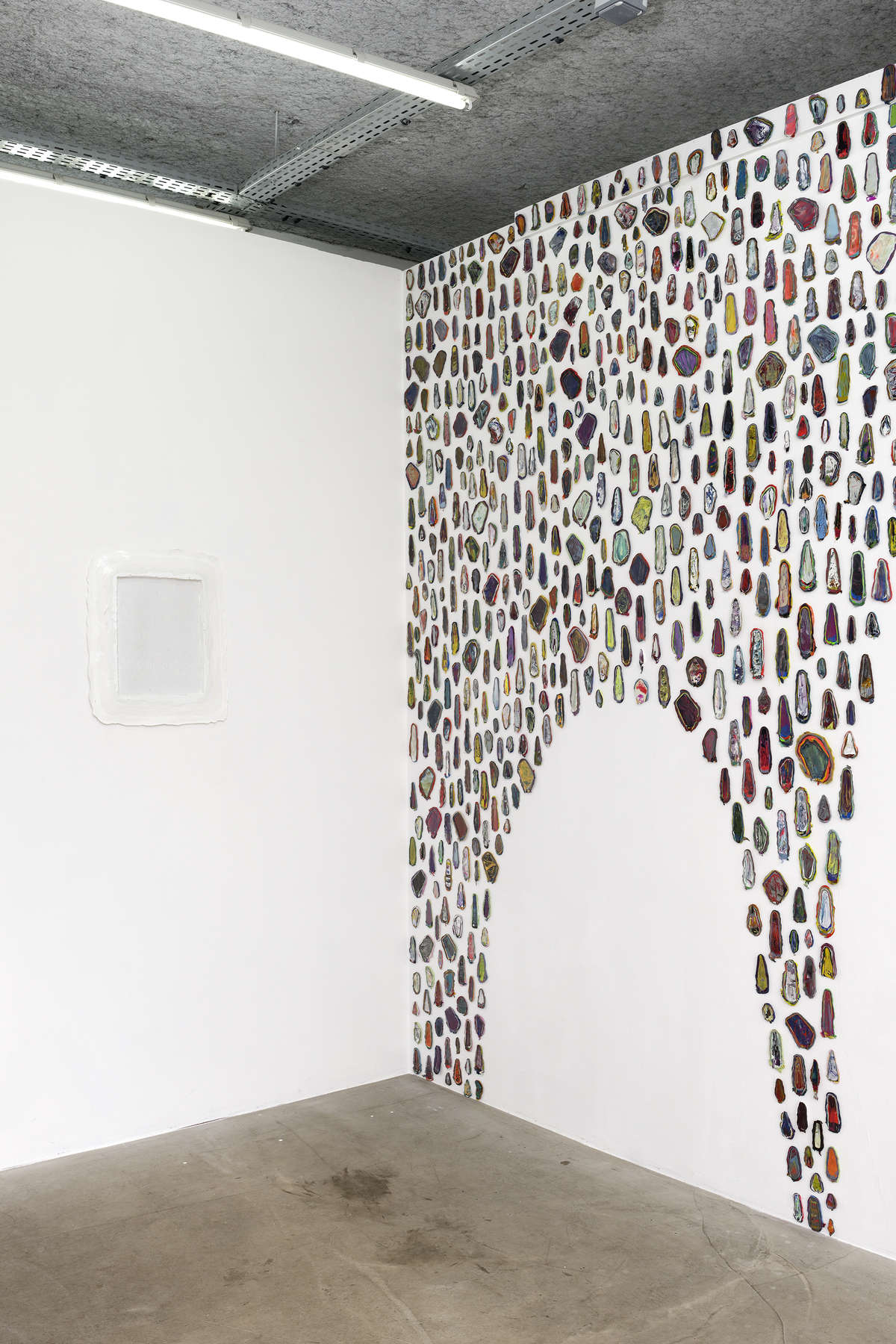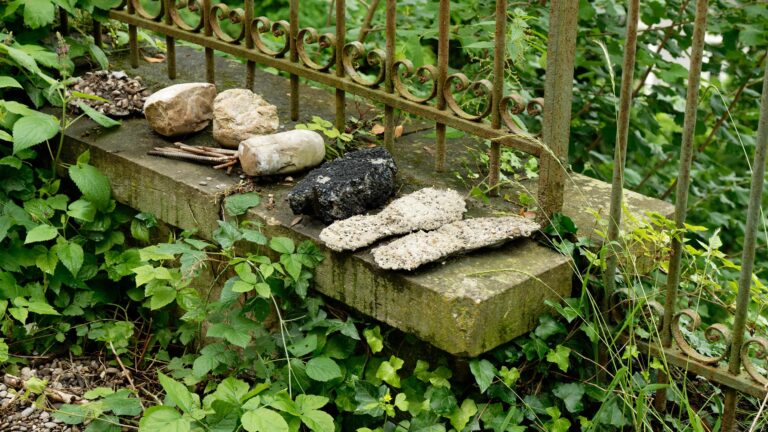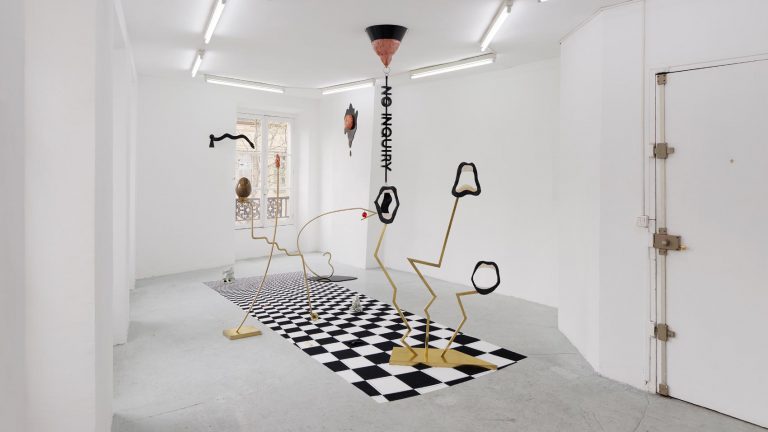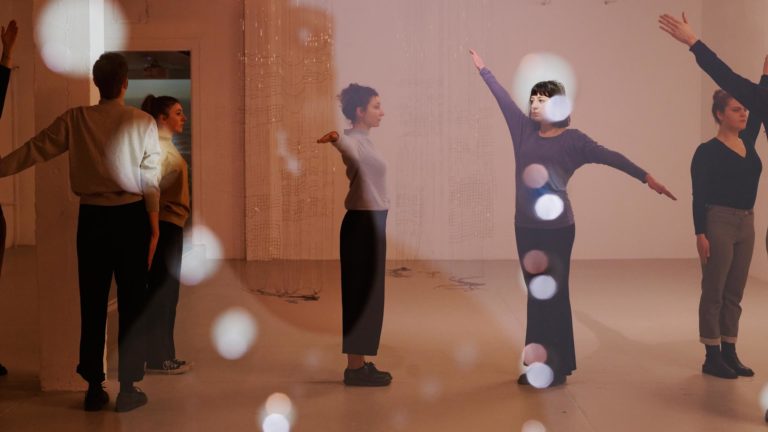Artist: Jacin Giordano
Exhibition title: Fossil
Venue: Sultana, Paris, France
Date: November 6– December 22, 2018
Photography: © aurélien mole / all images copyright and courtesy of the artist and Sultana, Paris
There is definitely a connection in wanting to bring the outside in to the gallery for the current show. That vibrant yellow is like sun shining on the walls and Giordano’s paintings always seem to reference landscape in one way or another.
Landscape can be a filter to help the artist thinks about the process of destruction and reconstruction in his own work too.
The centerpiece of the show is a multi-wall installation comprised of thousands individually molded pieces of acrylic paint called, Palette Knifeheads. The Knifeheads are artifacts of the studio that draw attention to their process and materiality while also doubling as a fantastic tool that evokes arrowheads or gems. The center of each Knifehead depicts details, gestures, colors, and marks culled from the language of 20th century painting like expressionistic brush strokes reminiscent of Abstract Expressionism, Impressionist daubs, color fields, monochromes, patterns, fingerprints, the color interactions of Josef Albers, Mondrian-ish geometries, etc. These moments are caught, frozen as if in amber; they are the building blocks with which Giordano continues to develop, but also relics that may be better left for dead.
The installation incorporates a lot of doors, portals, and rips which suggest another place can be entered through the work. There are a lot of paintings that mirror each other and objects that have twins because in the process of making them I literally slice the work open to create two halves. These “doubles” is another way of thinking about here versus there.
While the history of painting makes up part of Giordano’s starting point, he also draws from varied sources including the children’s story, The Rainbow Goblins, by Ul de Rico. It’s a story about seven colored creatures who hunt rain-bows and drink their color. The goblins use lassoes to collect color by transforming the ethereal light of a rainbow into physical liquid (not unlike paint). When the goblins go hunting in the “Valley of the Rainbow,” though, the flowers, trees, grass, and water fight back and kill the goblins by drowning them in a giant swirling pool of color.
As Giordano explains: “There are multiple parallels between the Rainbow Goblins and my own working practice.
Within my studio, goblins take on different forms. Sometimes I am the goblin. Like the goblin’s lassoes, I too have tools that I use to harness color and material in order to make my work. I’m interested in paint and color as a tangible substance. Sometimes the figures of art history are the monsters, and the swirling pools of paint I pour onto glass or freeze in paintings approximate the death of the goblins drowning. In my work, I use thickly layered acrylic paint, giving physical substance to the accumulation of painting’s history in order to create a space for these monsters.”
Shredded Paintings are influenced by Jean Arp’s collages, Selon les lois du hazard, and his Dadaist writings. When making the Shredded Paintings, Giordano uses leftover paint from one painting to another, then another, then another and so on. The more he re-uses these fragments the more they begin to alter in unanticipated ways. The once colorful leftovers lose intensity and wear down into smaller pieces. As this happens, the material, along with its initial decisions about color, composition, and shape, drift further away from my original intentions, inviting chance as a way to relinquish a certain amount of control. In the end the Shredded Paintings approximate the extracted remains of the fossilized Rainbow Goblins.
The Adpression series are made in a similar way as Knife heads; but instead of molding palette knifes, though, Giordano is molding canvases and stretcher bars. He is making paintings without scaffolding, using only material and process. Adpression is a term that describes fossils that leave both an impression mold and chemical/material residue,creating a kind of double fossil.
Jacin Giordano, Fossil, 2018, exhibition view, Sultana, Paris, photo: Aurélien Mole
Jacin Giordano, Fossil, 2018, exhibition view, Sultana, Paris, photo: Aurélien Mole
Jacin Giordano, Fossil, 2018, exhibition view, Sultana, Paris, photo: Aurélien Mole
Jacin Giordano, Fossil, 2018, exhibition view, Sultana, Paris, photo: Aurélien Mole
Jacin Giordano, Fossil, 2018, exhibition view, Sultana, Paris, photo: Aurélien Mole
Jacin Giordano, Fossil, 2018, exhibition view, Sultana, Paris, photo: Aurélien Mole
Jacin Giordano, Fossil, 2018, exhibition view, Sultana, Paris, photo: Aurélien Mole
Jacin Giordano, Adpression 10, 2018, acrylic, 53,5 x 43 cm , photo : Aurélien Mole
Jacin Giordano, Adpression 1 & 10, acrylic, 30 x 25 cm and 42 x 38 cm, 2018 photo: aurélien mole
Jacin Giordano, Adpression 11 & 12, acrylic, 38,75 x 30,48 cm each , 2018 photo: aurélien mole
Jacin Giordano, Shredded Painting 26, 2015, acrylic on canvas, photo: aurélien mole
Jacin Giordano, Shredded Painting, 35, 2015, acrylic on canvas, photo: aurélien mole
Jacin Giordano, Shredded Paintings, 34 & 48, acrylic on canvas, 25 x 20 cm, photo: aurélien mole
Jacin Giordano, Fossil, 2018, exhibition view, Sultana, Paris, photo: Aurélien Mole
Jacin Giordano, Fossil, 2018, exhibition view, Sultana, Paris, photo: Aurélien Mole
Jacin Giordano, Fossil, 2018, exhibition view, Sultana, Paris, photo: Aurélien Mole






















